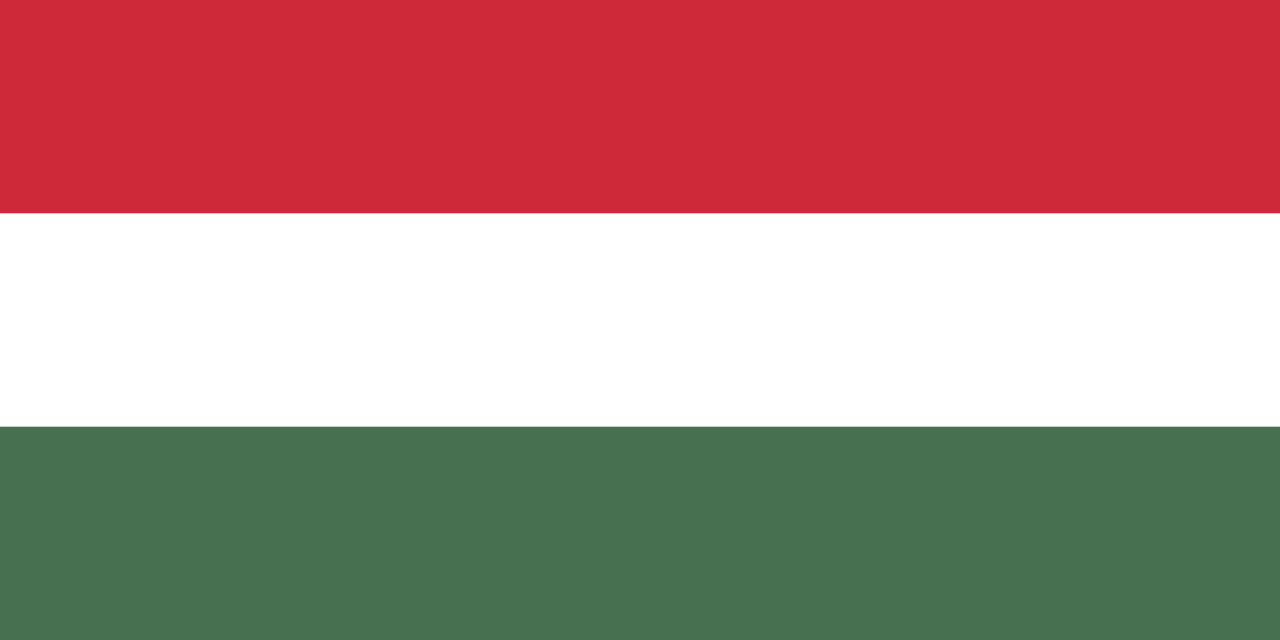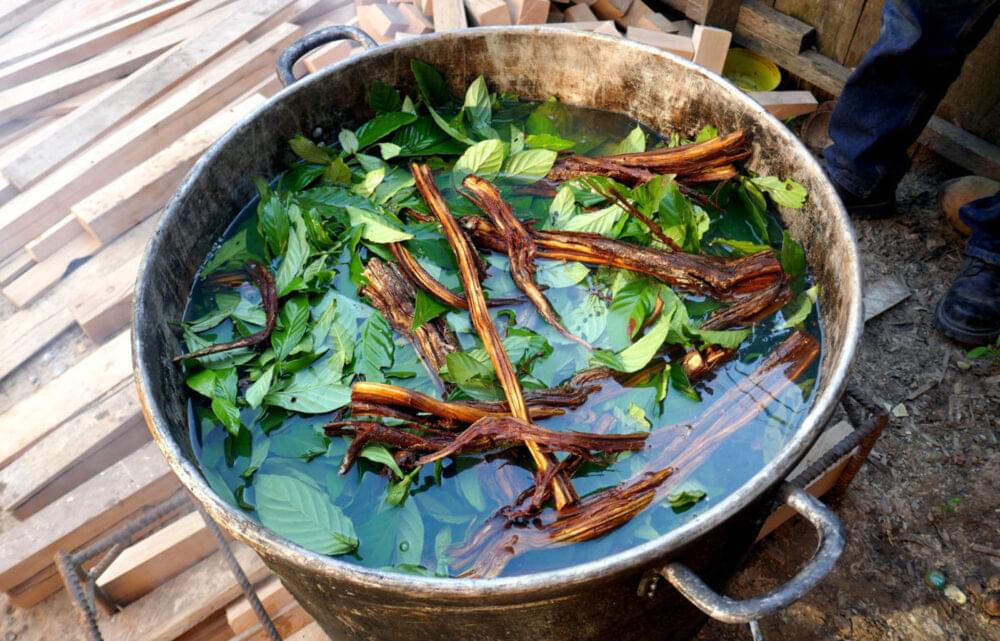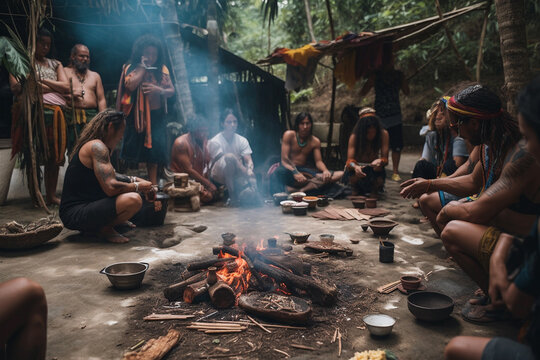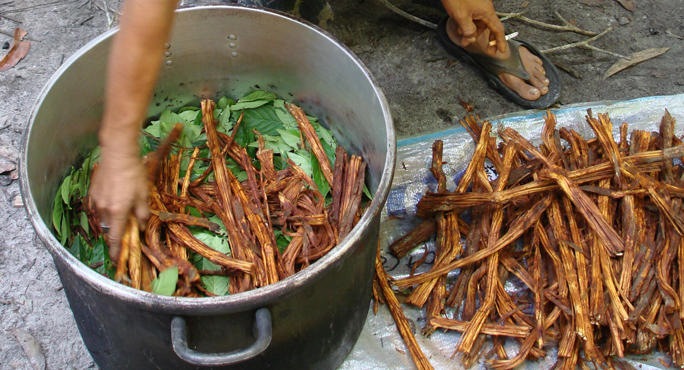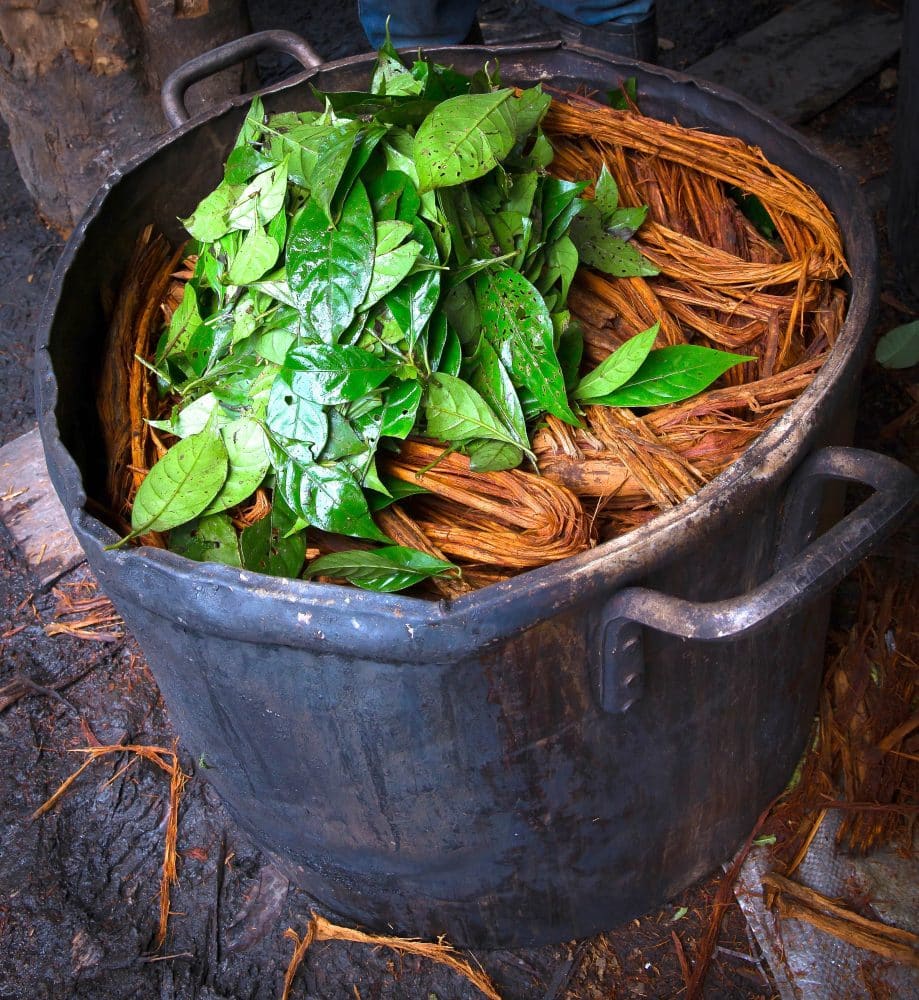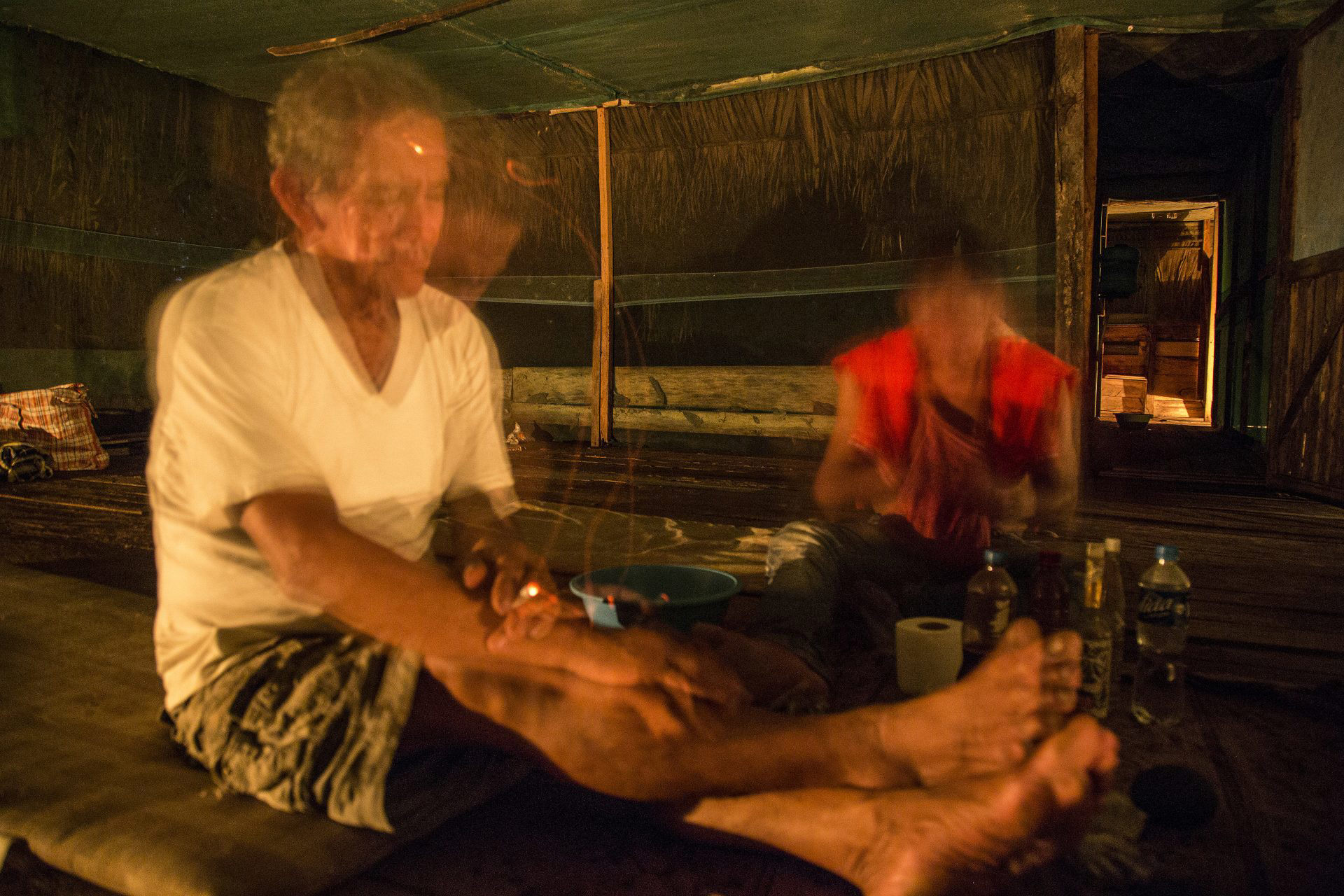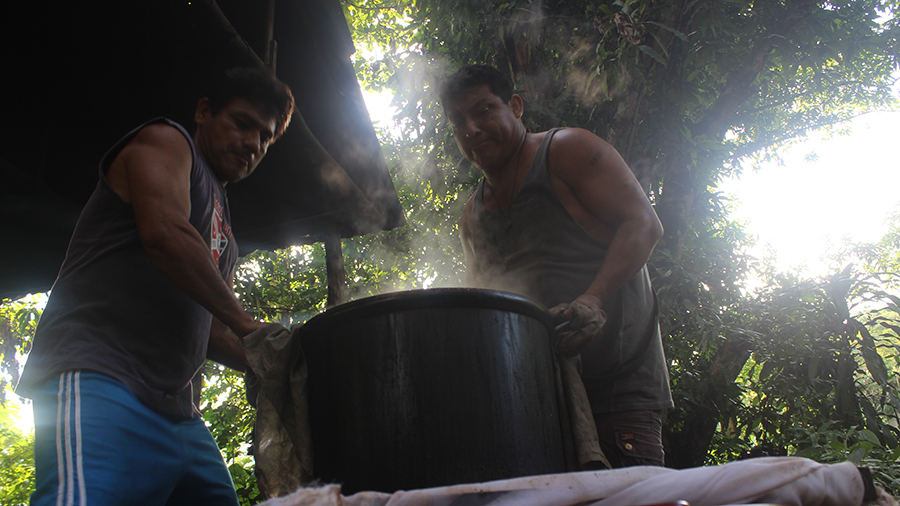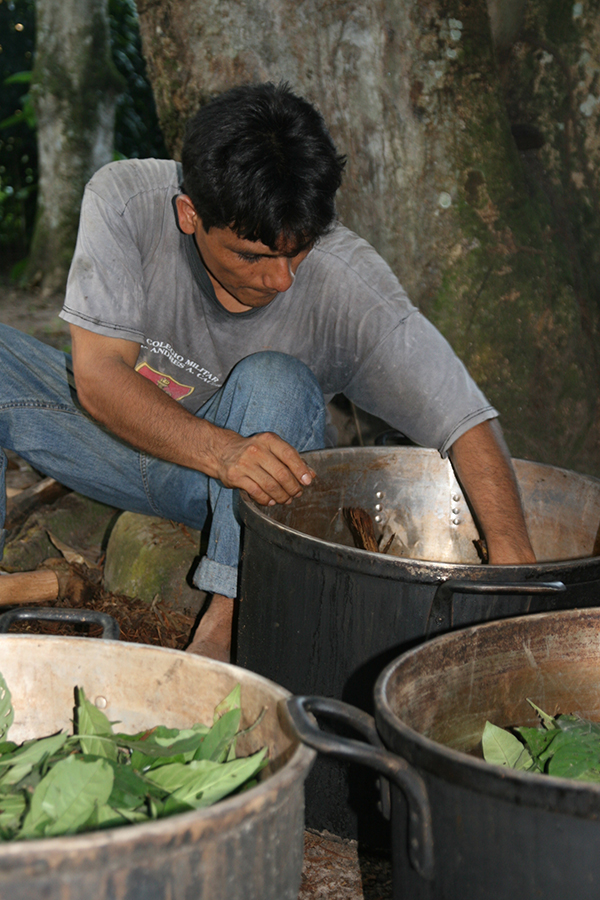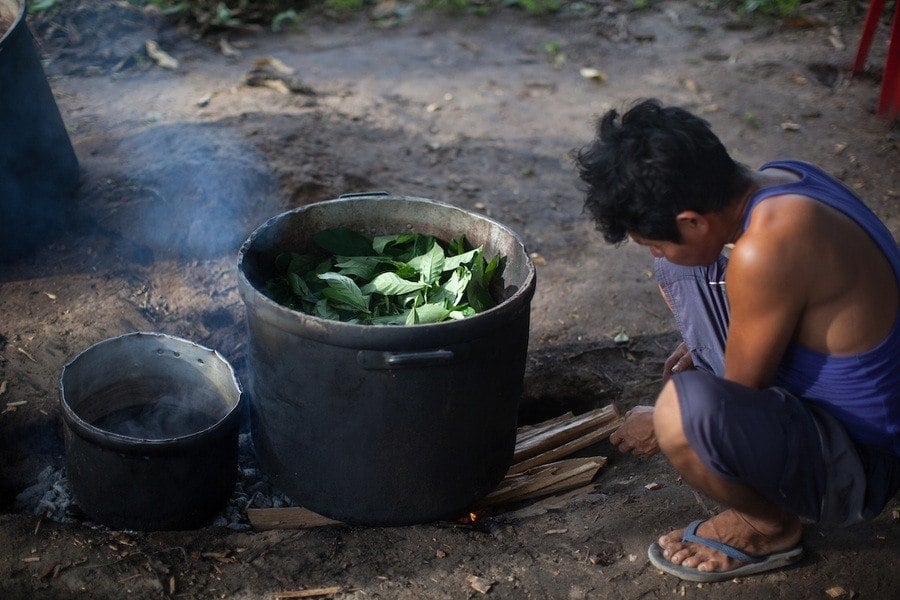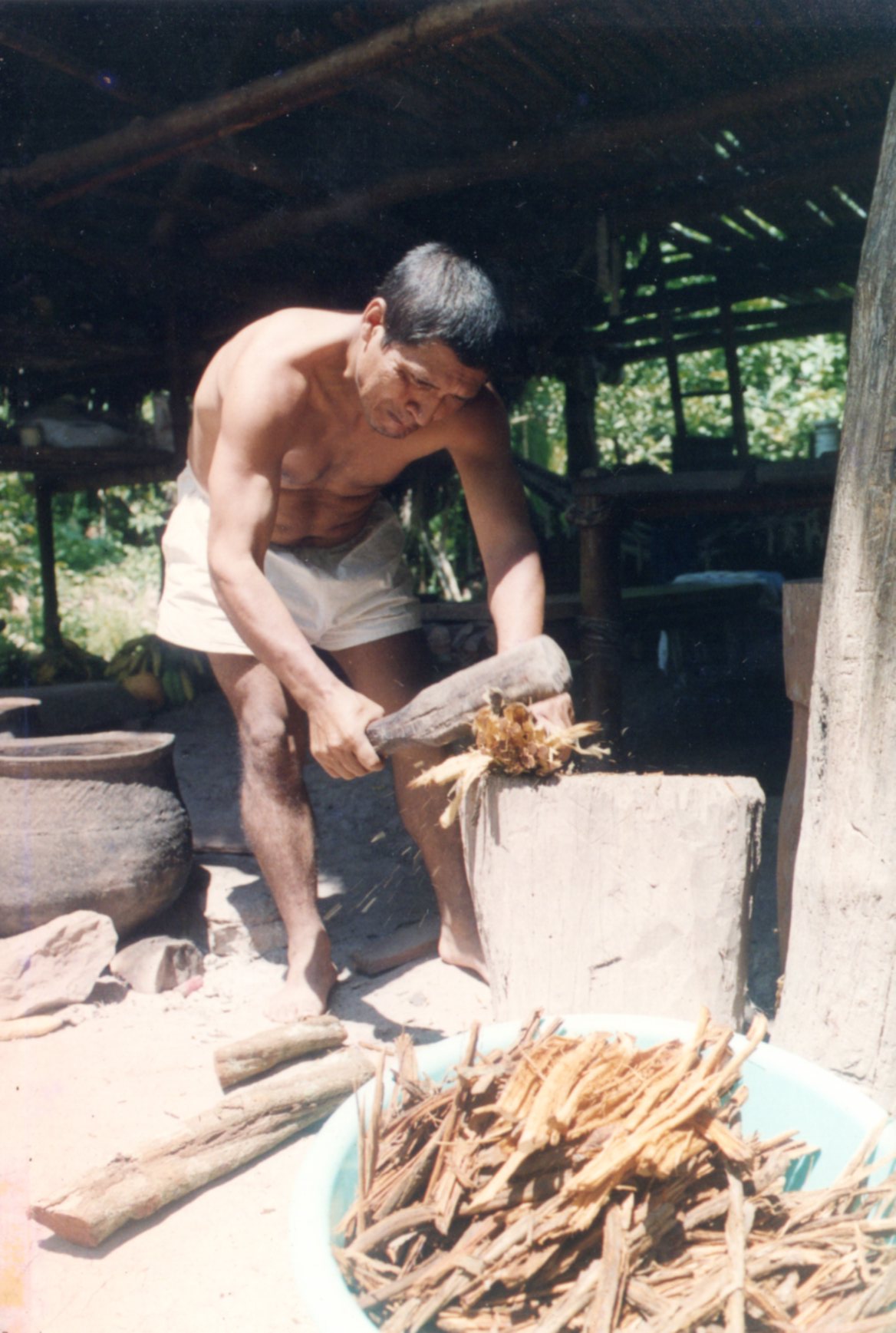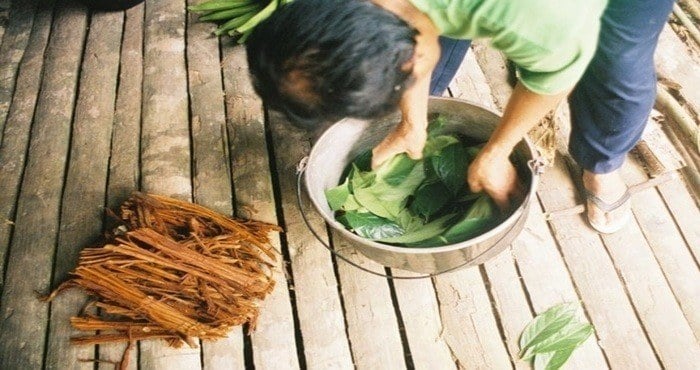What is Ayahuasca?
Ayahuasca is the teaching brew of the Amazon’s heart: the wisdom of the caapi vine and the vision of the “plants of light” in a single vessel, over a single night. It is not just an experience but a covenant with nature, the ancestors, and your own heart.
How is it seen in the rainforest?
Traditionally it is the drink of learning. The curandero/taita holds the space with icaros (healing songs); mapacho smoke protects, and the maracas and prayers provide focus. The purga—the bodily and emotional cleansing—is not a “side effect” but an honored gift that makes room for new insights.
What does it invite?
- Cleansing & reordering — a “deep clean” of body, mind, and heart.
- Vision & understanding — memories, patterns, and family stories reorganize, bringing new perspectives.
- Connection — a deeper relationship with nature, the ancestors, and community.
- Discipline — the plant “teaches”: simplicity, humility, self‑mastery.
What is ayahuasca not?
- Not a quick fix or “spiritual tourism.”
- It does not replace relationship, therapy, or responsibility — the path begins with integration.
- Not “one and done” — insights become real in everyday life.
Intention & holding space
The way is opened by intention: a clear request you return to again and again. The holding of space — songs, prayers, silence, attention — is the invisible vessel in which healing and learning can unfold safely. Community presence, mutual respect, and a disciplined diet are all part of this.
Integration
The ceremony is only the gate. Integration is when you turn the teaching into life: habits, relationships, work, rest, creativity. Journaling, prayer, time in nature, and sharing with community help anchor the insights.
Note: this is cultural/educational content; it is not medical or legal advice and does not encourage prohibited activity.
Effects, dosage & after‑effects
Ingredients and preparation
Ayahuasca is traditionally made from two main plants: the MAO‑A‑inhibiting alkaloids (such as harmine, harmaline, and tetrahydroharmine) found in the Banisteriopsis caapi vine, and the high levels of DMT in the leaves of Psychotria viridis (chacruna). The brew’s composition varies by ceremony, but an indigenous ratio often cited is 1 kg of caapi vine to 250–500 g of chacruna leaves. The plant material is boiled for hours until it becomes a thick, bitter drink, which is often served in 2–3 doses.
Dosage and active compounds
The beta‑carbolines (harmine, harmaline, THH) in the brew enable orally ingested DMT to be absorbed. Pharmacological studies suggest an active harmine dose around 8 mg/kg, though 1–2 mg/kg (about 70–150 mg) may be sufficient to allow oral DMT bioavailability.
The optimal DMT dose is 0.5–1 mg/kg; for a 70 kg person, a threshold is about 30 mg, an average dose ~50 mg, and a high dose ~70 mg. The poured volume per dose also varies across traditions: at Santo Daime 50–100 ml, in the Shuar tradition 20–30 ml, while in União do Vegetal (UDV) 100–200 ml per dose is typical; within one ceremony, 2–3 cups are common.
Alkaloid concentrations can vary widely (e.g., 0.16–14.15 mg/ml DMT and 0.45–22.85 mg/ml harmine), so potency differs from brew to brew. New participants are advised to begin with a small amount and increase only in the presence of an experienced leader.
Effects during the ceremony
Effects appear 30–90 minutes after ingestion, and the full experience typically lasts 4–6 hours. Mental and bodily effects can be perceived in three phases:
- Onset (30–45 min): nausea, dizziness, chills, sweating, often followed by vomiting or diarrhea (purga), which in tradition is understood as cleansing.
- Peak (1–3 hours): intense visual and auditory phenomena, distortions of time and space, deep introspection and emotional waves. Many report strong euphoria, a sense of unity, and encounters with nature, ancestors, or spiritual beings. Anxiety, fear, or panic can also appear, especially with high doses or negative mindset.
- Comedown (2+ hours): visions gradually fade; fatigue and exhaustion may be felt.
Physical side effects may include elevated heart rate, blood pressure, and body temperature, as well as tremor, muscle pain, and headache. At high doses, rare but severe reactions can occur (seizure or cerebral hyperstimulation). Those with cardiovascular or psychiatric illness should avoid the brew.
After‑effects and integration
After the acute phase there can be an afterglow: a sense of “being cleansed,” increased self‑confidence and inner peace, gratitude and warmth. Fatigue, hypersensitivity, temporary headache, dehydration, and sleep disturbance can also occur; these usually resolve within 24–72 hours.
Ayahuasca’s effects extend well beyond the night of ceremony: recall, self‑reflection, and life‑changes may last days, weeks, or even months. During integration, it is recommended to:
- Journal and record your thoughts.
- Meditate and practice mindfulness to consolidate inner learnings.
- Share with community: discussing the experience with group members or a therapist helps emotional processing.
- Practice self‑care: sufficient rest, healthy diet, physical activity, and time in nature.
Many communities emphasize avoiding alcohol, stimulants (caffeine, nicotine), antidepressants, and other psychoactives for at least a week after ayahuasca, as these can affect recovery.
Safety considerations
The brew contains MAO‑A inhibitors; it can be dangerous if someone is taking SSRI, SNRI, MAOI, or other psychiatric medications. Tyramine‑rich foods (aged cheeses, smoked meats, fermented drinks) are also to be avoided in the days before the ceremony, as they can cause a hypertensive crisis. To minimize risks, the ceremony should be led by a trained curandero or facilitator who helps adjust dosage, monitors reactions, and can provide immediate assistance if needed.
Diet and preparation
Guidelines: avoid red meat, fatty/spicy foods, salt, sugar, alcohol, and other substances; maintain sexual abstinence. Tyramine‑rich foods (aged cheeses, ferments, soy sauce, chocolate, cured meats) are to be avoided due to MAO inhibition.
Medications: especially antidepressants (SSRI/SNRI/MAOI/TCA), antipsychotics, amphetamines — taper for at least 2–6 weeks under medical supervision.
Spiritual perspective: the diet cleanses and refines perception, supporting connection with the plant spirit.
Master‑plant diets (training)
Extended retreats with no salt/sugar/spice, sexual and social abstinence; daily intake of a plant extract (e.g. bark tea). The plant “teaches”: it gives songs and conveys healing power. Closing is by dream/sign; the “dieted” plant later becomes a helping spirit.
Historical mentions
Archaeological and mythological evidence suggests ayahuasca has been known in the Amazon for centuries/millennia. 16th‑century Spanish chroniclers first wrote about “diabolical drinks.”
- 1851: British botanist Richard Spruce documents use of “caapi” along the Rio Negro (Tukano peoples) and collects specimens.
- 1858: Manuel Villavicencio uses the word “ayahuasca”; provides detailed descriptions of functions and experiences.
- 1923: crystalline alkaloid isolated from B. caapi bark extract — “telepathine”.
- 1940–: Richard Evans Schultes conducts fieldwork; subsequent botanical/ethnographic research (Dennis & Terence McKenna).
Counterculture (late 20th c.) also discovers it: Burroughs & Ginsberg, The Yage Letters (1963). Science has since clarified that “telepathine” is identical to harmine.
Modern research
Antidepressant effects
- 2015 (Brazil): open‑label trial in 6 treatment‑resistant patients; ~18% score reduction at 24h (to ~82% of baseline), with effects lasting ~21 days.
- 2018: randomized, placebo‑controlled trial — rapid mood improvement within 1–2 days, effects lasting ~2 weeks.
Neurogenesis & neuroplasticity
- In vitro: harmine/harmaline/THH increase neural progenitor proliferation, migration, and differentiation.
- Animal models: DMT, via σ1‑receptor agonism, increases hippocampal neurogenesis; improved memory performance.
- fMRI: reduced “network rigidity” (DMN dominance) and increased inter‑regional communication.
Anxiety, PTSD, addictions
- Small studies: reduced anxiety; improvements in PTSD aspects (case reports).
- Rehab programs (Canada/Brazil): reduced craving, improved self‑esteem, months‑long abstinence — context‑dependent outcomes.
Other effects
- Receptors: serotonergic, dopaminergic, glutamatergic, and endocannabinoid systems; VMAT, TAAR1 modulation.
- Biomarkers: increased BDNF, decreased inflammatory cytokines → possible neuroprotective and anti‑inflammatory effects.
Note: these are early‑phase, often small‑sample studies; effects of the complex brew depend on many variables. Larger RCTs are needed.
Contraindications, drug interactions, risks
Drug interactions (MAOI hazards)
- Antidepressants (SSRI/SNRI/MAOI/TCA), antipsychotics, amphetamines, MDMA, opiates — do not combine.
- Risk of serotonin syndrome: agitation, tremor, seizures, hypertension, hyperthermia, cardiovascular collapse; deaths have been documented.
- Herbal: St. John’s wort (Hypericum perforatum) — avoid.
Physiological contraindications
- Cardiovascular disease: arrhythmia, unstable blood pressure, angina, heart failure — risk of increased pulse/BP.
- Cerebral aneurysm, severe atherosclerosis → stroke risk.
- Liver disease: metabolic risks with MAO inhibition.
- Pregnancy: contraindicated (toxicity + purga/BP fluctuations).
- Epilepsy: seizure‑provocation risk.
Psychiatric contraindications
- Psychotic disorders, schizophrenia, bipolar I — risk of severe worsening; case reports of chronic episodes.
- Suicidal ideation: a bad trip can aggravate.
Acute psychological risks even for healthy people
- Bad trip, panic, paranoia; the presence of a trained facilitator and a safe setting is essential.
- Personnel prepared for rare medical emergencies is recommended.
Physical side effects
- Purga (vomiting/diarrhea) → fluid replacement is important.
- Sweating, tremor, chills; temporary loss of coordination.
- Muscle tension/pain, photosensitivity (dilated pupils), headache, chest tightness, dizziness.
Long‑term psychological side effects
- Rare: HPPD (visual disturbances for weeks) in frequent users.
- In predisposed individuals, risk of persistent psychosis — screening is crucial.
Responsible protocols (exclusion, informed consent, emergency plan, post‑integration) can significantly reduce risks.
Legal status in international context
The brew contains DMT, which under the 1971 UN Convention on Psychotropic Substances is a Schedule I substance; the plants themselves (B. caapi, P. viridis) are not listed — national interpretation varies widely.
South America
- Peru (2008): ayahuasca and its knowledge recognized as national cultural heritage; legal within traditional/commercial frameworks.
- Brazil (1992, 2010 CONAD): religious use permitted, with guidelines: commercial sale prohibited, ceremonial use protected.
- Colombia: protected/tolerated in traditional contexts.
North & Central America
- Mexico, Costa Rica: not explicitly scheduled; tourism flourishes; CR authorities show caution (requests for notification).
- USA: DMT is federally Schedule I; exceptions: UDV (2006 Supreme Court) and Santo Daime (2009 Oregon) — religious exemptions for ceremonial use.
- Canada: prohibited, but religious exemptions granted to some organizations (since 2017).
Europe
- France (2005): B. caapi, P. viridis, harmaline, DMT on a specific prohibition list.
- Belgium, Switzerland, Italy, Sweden, Denmark, Ireland: generally illegal (due to DMT content).
- Netherlands (2019): Supreme Court ruled Daime brew illegal → religious exception withdrawn.
- Spain: brew classified as a “toxic preparation” → distribution banned; personal use not criminalized.
- Portugal (2001): decriminalization → possession not a crime; trafficking prohibited.
Hungary
- The active substance, DMT, is classified as a narcotic in Hungary: schedules are defined by 78/2022. (XII. 28.) BM decree Annexes 1–2; enforcement frameworks by 66/2012. (IV. 2.) Government decree.
- Ayahuasca itself is not listed by name, but due to its DMT content, production, possession, import/export, and distribution — without authorization — are prohibited.
- Under the Criminal Code (Act C of 2012) §178 (possession of narcotics), acquisition, possession, import/export, etc., constitute a crime; baseline penalty is 1–5 years imprisonment, with harsher penalties for aggravated cases (e.g., significant quantity, trafficking, criminal organization).
- For first‑time offenders with small quantities, the law recognizes diversion (participation in a preventive‑educational program), which under certain conditions may terminate punishability. Details vary case by case; seek legal counsel.
Warning: in Hungary, legal risks around DMT and DMT‑containing brews are high. The above summary is for information only; consult a lawyer for specific cases.
International effort: potential UNESCO‑level cultural heritage recognition (Brazil’s initiative) — no consensus.
Sustainability, ethics, and commercial issues
Ecology and renewal
- Rising global demand → risk of overharvesting; slow growth; habitat loss (deforestation).
- Ayni Ayahuasca program (Chaikuni Institute / Temple of the Way of Light, 2018–): promotes cultivation, agroforestry, local income, and sustainable harvesting protocols.
- Planted stocks (~1800 vines reported); ~10 years to harvest; goal is self‑sufficiency.
Ethics and cultural dimensions
- Risk of cultural appropriation; notable case: the “ayahuasca patent” (Da Vine, 1986) — revoked in 1999 amid biopiracy criticism.
- Principles of the Nagoya Protocol: indigenous consent and equitable benefit‑sharing from knowledge use.
- Power imbalances, self‑proclaimed “shamans,” abuses (e.g., sexual misconduct): require ethical standards and transparency.
Commercial aspects
- Ayahuasca tourism can be community‑building but also risky (danger of exploitation).
- Raw‑material trade: vine powder/chipped bark online (“collector’s item”) — lack of quality control, legal grey areas.
Outlook: multipolar dialogue (indigenous leaders, scientists, lawyers), respectful and sustainable practices (e.g., Chacruna, ICEERS). The goal is balance between honoring tradition, protecting nature, and responsible Western application.
